Abstract
Summary
In a global survey of fracture liaison services, most reported that DXA access met needs. However, adherence to basic DXA quality and reporting procedures was confirmed by only around 50% of institutions and many required education for operators/interpreters. Overall, there is significant variability in the access to, and quality of, DXA services worldwide.
Introduction
While the use of dual-energy X-ray absorptiometry (DXA) has been widely adopted worldwide for the assessment of bone mineral density, the quality of DXA facilities is unknown. To address this, a global survey of fracture liaison services (FLS) was conducted by the International Society for Clinical Densitometry (ISCD) and the International Osteoporosis Foundation (IOF) to assess the quality of their DXA facilities.
Methods
A questionnaire for the accessibility and quality of DXA services was co-created by representatives of the ISCD and the IOF and made available to institutions who participated in the Capture the Fracture Best Practice Framework. From a list of 331 contacted invitees, 124 FLS centres responded; analyses were based on 121 centres with suitable data.
Results
Over 70% of institutions reported that, for over 90% of the time, DXA access met service needs, and the scanning/reporting quality was perceived as excellent. However, 25% of DXA facilities reported not being accredited by a professional/governmental organization, and adherence to some basic DXA quality assurance and reporting procedures was confirmed by < 50% of services. Importantly, in excess of 50% of institutions stated that they desired ongoing education in osteoporosis and DXA for operators and interpreters.
Conclusion
There is significant variability in the access to and quality of DXA services for established FLS worldwide. Despite two decades of training initiatives in osteoporosis densitometry, many centres are falling short of the standards of the IOF-ISCD Osteoporosis Essentials criteria.






Similar content being viewed by others
References
Johnell O, Kanis J (2006) An estimate of the worldwide prevalence and disability associated with osteoporotic fractures. Osteoporos Int 17:1726–1733
Hernlund E, Svedbom A, Ivergård M, Compston J, Cooper C, Stenmark J, McCloskey EV, Jönsson B, Kanis JA (2013) Osteoporosis in the European Union: medical management, epidemiology and economic burden. Arch Osteoporos 8:136
Marshall D, Johnell O, Wedel H (1996) Meta-analysis of how well measures of bone mineral density predict occurrence of osteoporotic fractures. BMJ 312:1254–1259
Kanis J, Odén A, Johnell O, Johansson H, De Laet C, Brown J, Burckhardt P, Cooper C, Christiansen C, Cummings S, Eisman J, Fujiwara S, Glüer C, Goltzman D, Hans D, Krieg M, La Croix A, McCloskey E, Mellstrom D, Melton L, Pols H, Reeve J, Sanders K, Schott A, Silman A, Torgerson D, van Staa T, Watts N, Yoshimura N (2007) The use of clinical risk factors enhances the performance of BMD in the prediction of hip and osteoporotic fractures in men and women. Osteoporos Int 18:1033–1046
Kanis J, Johnell O, Odén A, Johansson H, McCloskey E (2008) FRAX™ and the assessment of fracture probability in men and women from the UK. Osteoporos Int 19:385–397
Kanis J (1989) Osteoporosis--the silent epidemic. Health Visit 62:14–15
Curtis EM, Moon RJ, Harvey NC, Cooper C (2017) The impact of fragility fracture and approaches to osteoporosis risk assessment worldwide. Bone 104:29–38
Mithal A, Bansal B, Kyer CS, Ebeling P (2014) The Asia-Pacific regional audit-epidemiology, costs, and burden of osteoporosis in India 2013: a report of International Osteoporosis Foundation. Indian J Endocrinol Metab 18:449–454
Kanis J, Johnell O (2005) Requirements for DXA for the management of osteoporosis in Europe. Osteoporos Int 16:229–238
Harvey NC, McCloskey EV, Mitchell PJ, Dawson-Hughes B, Pierroz DD, Reginster J-Y, Rizzoli R, Cooper C, Kanis JA (2017) Mind the (treatment) gap: a global perspective on current and future strategies for prevention of fragility fractures. Osteoporos Int 28:1507–1529
Overman RA, Farley JF, Curtis JR, Zhang J, Gourlay ML, Deal CL (2015) DXA utilization between 2006 and 2012 in commercially insured younger postmenopausal women. J Clin Densitom 18:145–149
Lewiecki EM, Binkley N, Morgan SL, Shuhart CR, Camargos BM, Carey JJ, Gordon CM, Jankowski LG, Lee J-K, Leslie WD (2016) Best practices for dual-energy X-ray absorptiometry measurement and reporting: International Society for Clinical Densitometry Guidance. J Clin Densitom 19:127–140
Messina C, Bandirali M, Sconfienza LM, D’Alonzo NK, Di Leo G, Papini GDE, Ulivieri FM, Sardanelli F (2015) Prevalence and type of errors in dual-energy x-ray absorptiometry. Eur Radiol 25:1504–1511
Promma S, Sritara C, Wipuchwongsakorn S, Chuamsaamarkkee K, Utamakul C, Chamroonrat W, Kositwattanarerk A, Anongpornjossakul Y, Thamnirat K, Ongphiphadhanakul B (2018) Errors in patient positioning for bone mineral density assessment by dual X-ray absorptiometry: effect of technologist retraining. J Clin Densitom 21:252–259
Krueger D, Shives E, Siglinsky E, Libber J, Buehring B, Hansen K, Binkley N (2019) DXA errors are common and reduced by use of a reporting template. J Clin Densitom 22:115–124
Ganda K, Puech M, Chen J, Speerin R, Bleasel J, Center J, Eisman J, March L, Seibel M (2013) Models of care for the secondary prevention of osteoporotic fractures: a systematic review and meta-analysis. Osteoporos Int 24:393–406
Sale J, Beaton D, Posen J, Elliot-Gibson V, Bogoch E (2011) Systematic review on interventions to improve osteoporosis investigation and treatment in fragility fracture patients. Osteoporos Int 22:2067–2082
Marsh D, Åkesson K, Beaton D, Bogoch E, Boonen S, Brandi M-L, McLellan A, Mitchell P, Sale J, Wahl D (2011) Coordinator-based systems for secondary prevention in fragility fracture patients. Osteoporos Int 22:2051–2065
Eisman JA, Bogoch ER, Dell R, Harrington JT, McKinney RE Jr, McLellan A, Mitchell PJ, Silverman S, Singleton R, Siris E (2012) Making the first fracture the last fracture: ASBMR task force report on secondary fracture prevention. J Bone Miner Res 27:2039–2046
Kanis J, Cooper C, Rizzoli R, Reginster J (2019) European guidance for the diagnosis and management of osteoporosis in postmenopausal women. Osteoporos Int 30:3–44
Greenspan SL, Wyman A, Hooven FH, Adami S, Gehlbach S, Anderson FA Jr, Boone S, Lacroix AZ, Lindsay R, Netelenbos J, Pfeilschifter J, Silverman S, Siris E, Watts N (2012) Predictors of treatment with osteoporosis medications after recent fragility fractures in a multinational cohort of postmenopausal women. J Am Geriatr Soc 60:455–461
Osteoporosis Canada (2014) Quality Standards for Fracture Liaison Services in Canada. https://wwwosteoporosisca/wp-content/uploads/OC-Quality-Standards-ENG-Nov-2014pdf Accessed 15 Apr 2020
Osteoporosis New Zealand (2016) Clinical Standards for Fracture Liaison Services in New Zealand. https://osteoporosisorgnz/wp-content/uploads/ONZ-FLS-Clinical-Standards-WEBpdf Accessed 15 Apr 2020
Royal Osteoporosis Society (2019) Effective secondary prevention of fragility fractures: clinical standards for fracture liaison services. https://therosorguk/media/1eubz33w/ros-clinical-standards-for-fracture-liaison-services-august-2019pdf Accessed 15 Apr 2020
Åkesson K, Marsh D, Mitchell PJ, McLellan A, Stenmark J, Pierroz D, Kyer C, Cooper C (2013) Capture the Fracture: a Best Practice Framework and global campaign to break the fragility fracture cycle. Osteoporos Int 24:2135–2152
Javaid M, Kyer C, Mitchell P, Chana J, Moss C, Edwards M, McLellan A, Stenmark J, Pierroz D, Schneider M, Kanis J, Akesson K, Cooper C (2015) Effective secondary fracture prevention: implementation of a global benchmarking of clinical quality using the IOF capture the fracture® Best Practice Framework tool. Osteoporos Int 26:2573–2578
Funding
This study was funded by the following organizations: International Society for Clinical Densitometry; International Osteoporosis Foundation; UK Medical Research Council; University of Southampton.
Author information
Authors and Affiliations
Consortia
Corresponding author
Ethics declarations
Conflicts of interest
MAC reports personal fees (outside the submitted work) from UCB, Pfizer, and Eli Lilly for conference attendance; CC reports personal fees (outside the submitted work) from Amgen, Danone, Eli Lilly, GSK, Kyowa Kirin, Medtronic, Merck, Nestle, Novartis, Pfizer, Roche, Servier, Shire, Takeda and UCB. EMD reports personal fees (outside the submitted work) from Pfizer Healthcare and from the UCB Discussion panel. NCH reports consultancy, lecture fees and honoraria (outside the submitted work) from Alliance for Better Bone Health, AMGEN, MSD, Eli Lilly, Servier, Shire, UCB, Kyowa Kirin, Consilient Healthcare, Radius Health and Internis Pharma. JAK reports grants (outside the submitted work) from Radius Health, Amgen and UCB. CRS reports Consultant for Amgen and President of the International Society for Clinical Densitometry (2019–2020). All other authors declare that they have no conflicts of interest.
Human and animal rights
This article does not contain any studies with human participants or animals performed by any of the authors.
Additional information
Publisher’s note
Springer Nature remains neutral with regard to jurisdictional claims in published maps and institutional affiliations.
Electronic supplementary material
ESM 1
(DOCX 42 kb)
Rights and permissions
About this article
Cite this article
Clynes, M.A., Westbury, L.D., Dennison, E.M. et al. Bone densitometry worldwide: a global survey by the ISCD and IOF. Osteoporos Int 31, 1779–1786 (2020). https://doi.org/10.1007/s00198-020-05435-8
Received:
Accepted:
Published:
Issue Date:
DOI: https://doi.org/10.1007/s00198-020-05435-8




